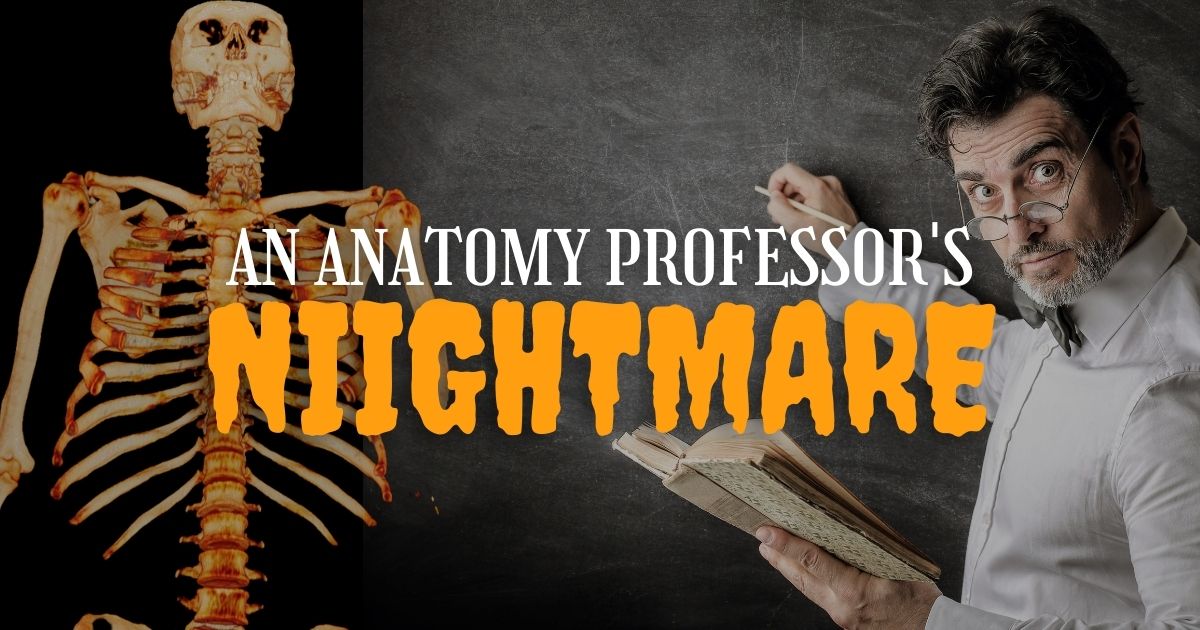An Anatomy Professor's Nightmare
October 18, 2021

Nothing is more infuriating to a professor than looking up from your lecture to an audience of zombies captivated by their phones.
Professors are in constant competition for their students' attention - especially against the notifications of their students’ phones and laptops.
Lisa Wade, wrote an article for the Business Insider highlighting “10 Things Every College Professor Hates”. Any professor and teacher alike who reads through this list can relate to all of them. Today we are unveiling what specifically is an Anatomy professor’s nightmare and how Anatomy and Biology instructors can prevent their nightmares from coming true!
A BIG responsibility.
Kinesiology, Pre-med, Biology, Biomedical, Bioengineering, Exercise Science, Pre-Dental, Pre-Chiropractic, Pre-Veterinary, Physical Therapist, Physician Assistant, etc. The list of majors and departments that require human anatomy is long and not limited to the ones listed. A solid understanding of human anatomy is crucial and considered a foundation for many majors and career paths. Professors in Anatomy and Biology are training the future doctors, surgeons, medical professionals, and vets of the world. If the next generation of students is not understanding these concepts, the future of the medical field is at stake. Instructors have a responsibility to society to make sure their students are receiving a solid foundation to their future health career.
We know that teaching students Anatomy is much easier said than done.
Trying to win students’ attention over their phone and laptop notifications is an Anatomy professor's nightmare. A student reading a text, scrolling through Instagram and TikTok during a lecture, can be the difference between a student understanding the answer for problem 10 on the upcoming exam and missing it. Some professors believe that this problem can be eliminated by a zero technology policy in class. However, with the world advancing in virtual learning resources, the idea of eliminating technology in class is becoming unrealistic. Students use their laptops for taking notes, responding to Kahoot and TopHat quizzes, and following along with lecture slides.
It almost seems that the competition for students' attention is similar to natural selection’s survival of the fittest idea. Students who have the dedication to pay attention during class perform better academically and this same dedication will potentially transfer into their academic careers. Students who cannot demonstrate this sort of self-control typically do not perform as well academically, and this may limit their future opportunities.
As instructors, you want to help all students overcome this challenge. The answer for how to keep students’ attention is not to take technology away since it has proven to provide great academic benefits. Instead of restricting technology, at BodyViz we believe instructors should actually be encouraging it to be used as a learning tool through 3D virtual dissection!
If you cannot beat them, join them.
BodyViz has 3D anatomy dissection software that is engaging for students! Imagine a class where students have their laptops and tablets out and are following along with the lecture as you virtually dissect, annotate, examine, and color the real anatomy from an actual patient that is being displayed on the lecture screen. Students are captivated by this realistic application and combination of 3D anatomy and technology. When students understand the application of what they are learning, they are more likely to remember the concept and perform better on assignments. By using 3D anatomy software that displays real human anatomy, the application of human anatomy concepts is taken to a new level of understanding. With modeled anatomy that oftentimes looks “cartoony” and unrealistic - students can have a disconnect of the application. When you place the 3D anatomy of an actual patient with their age, gender, medical facts, and more - the information is real and has life. Students find this fascinating!

BodyViz has demonstrated success in high school, undergraduate, post-graduate, health care, CTE, human anatomy, and veterinary science classrooms. Dr. MohanKumar from the University of Georgia’s College of Veterinary Medicine, has seen great success in student’s understanding and interest because of using BodyViz 3D anatomy lab software in his courses: “Let’s say we are dissecting the front limb of a dog and there is a bone broken or a tumor,” Dr. MohanKumar says. “We link that clinical scenario with whatever the students are dissecting. That way when they ask, ‘Why am I dissecting this? Why am I learning this thing? Why do I have to memorize this specific fact?’ This is the reason. We constantly bring it back to clinical relevance.” Giving students even at a basic secondary or 101 level, clinical relevance with real anatomy will help them to see the bigger picture of what they are learning. Online dissection featuring real, 3D anatomy with BodyViz allows for limitless learning opportunities with 1,000s of patient cases. BodyViz helps students experience REAL anatomy and can help you improve class engagement and comprehension!
Keep your anatomy nightmares away and schedule a demo! A BodyViz representative will answer your questions and help you determine a customizable solution that is best for you and your class!
Schedule Demo
Helpful Links
Reference:
10 Things Every College Professor Hats by Lisa Wade